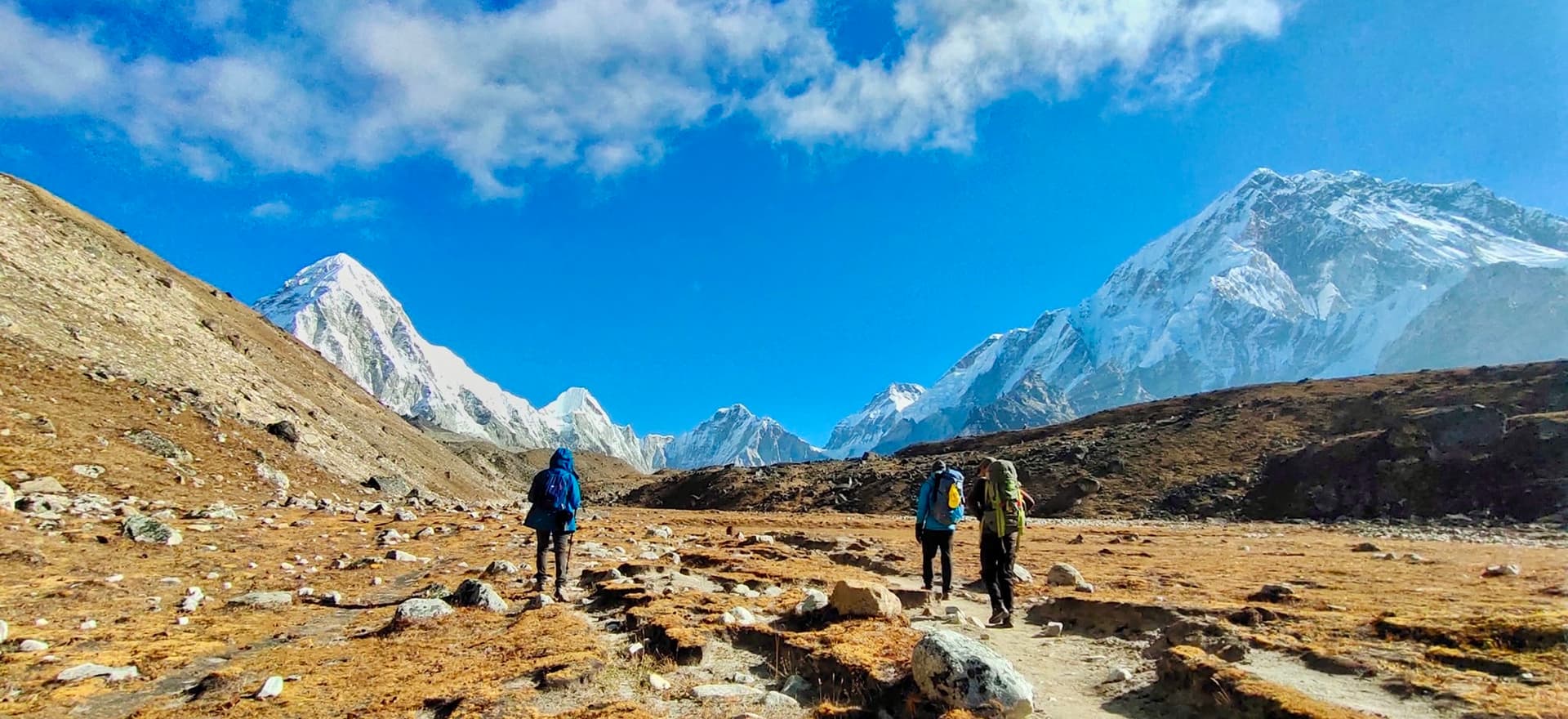We can't think of a better time to explore Nepal's breathtaking mountains than during autumn. From late September through November, Nepal transforms into a trekker's paradise with crystal-clear mountain views, comfortable temperatures, and vibrant cultural festivals that make every trail come alive.
This guide is for adventurers ready to experience Nepal's legendary peaks at their most spectacular – from first-time trekkers planning their dream Everest Base Camp journey to seasoned hikers looking to tackle the Annapurna Circuit under perfect conditions.
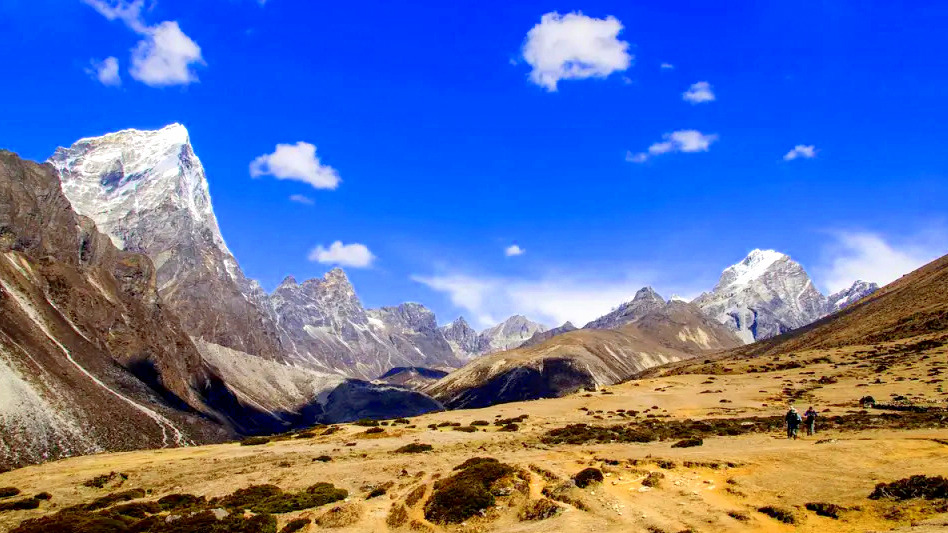
We'll walk you through why autumn reigns supreme for Nepal trekking, showing you exactly when the weather conditions peak for maximum mountain visibility and comfortable hiking temperatures. You'll discover our top autumn trekking routes that take full advantage of this season's unique benefits, plus get our complete packing guide so you're prepared for Nepal's crisp mountain mornings and warm afternoon sun.
Ready to plan your autumn adventure? We'll also share insider tips for booking and planning your trek during Nepal's most popular (and most rewarding) trekking season.
Why Autumn Reigns Supreme for Nepal Trekking
Perfect Weather Windows with Clear Mountain Views
When we're planning treks across Nepal's magnificent landscapes, autumn delivers the most breathtaking mountain views we've ever witnessed. The monsoon rains have washed the air clean, leaving behind crystal-clear skies that showcase the Himalayas in all their glory. We consistently find that visibility extends far beyond what we experience during other seasons, with mountain peaks appearing sharp and defined against brilliant blue skies.
During our autumn expeditions, we regularly enjoy unobstructed views of iconic peaks like Everest, Annapurna, and Manaslu. The atmospheric conditions create perfect windows for mountain photography, with the golden light of autumn enhancing the dramatic contrasts between snow-capped summits and deep valleys below. We've discovered that these clear conditions typically last for days at a time, giving us multiple opportunities to capture those once-in-a-lifetime shots.
The post-monsoon atmosphere removes the haze and dust that often obscures mountain views during other seasons. We can see distant peaks that remain hidden during spring and winter months, creating panoramic vistas that stretch across multiple mountain ranges. Our trekkers consistently tell us that the clarity of autumn views exceeds their expectations, making every step of the journey worthwhile.
Stable Temperatures for Comfortable Walking
Autumn provides us with the most comfortable temperature ranges for extended trekking across Nepal's diverse elevation zones. We find that daytime temperatures remain pleasantly warm without becoming oppressive, typically ranging from 15-20°C (59-68°F) at moderate altitudes. These conditions allow our trekkers to maintain steady paces without overheating or struggling with extreme cold.
During our autumn treks, we notice that temperature fluctuations remain relatively modest compared to the dramatic swings we encounter in spring and winter. Nighttime temperatures drop enough to provide refreshing sleep conditions without becoming uncomfortably cold for most trekkers. We typically see overnight lows between 5-10°C (41-50°F) at popular trekking elevations, which most people find manageable with proper gear.
The stable temperature patterns mean we can predict clothing needs more accurately, helping our trekkers pack efficiently without carrying unnecessary weight. We've observed that these consistent conditions reduce the physical stress of adaptation, allowing trekkers to focus on enjoying the experience rather than battling challenging weather elements. The moderate temperatures also mean that high-altitude locations remain accessible without extreme cold-weather gear requirements.
Minimal Rainfall Risk Compared to Other Seasons
Our experience across thousands of autumn treks shows dramatically reduced precipitation compared to monsoon and pre-monsoon seasons. We typically encounter only occasional light showers during autumn months, usually brief afternoon sprinkles that clear quickly without disrupting trekking schedules. This reliability allows us to plan itineraries with confidence, knowing that weather delays are uncommon.
The transition from monsoon to autumn creates stable high-pressure systems that push moisture-laden clouds away from trekking regions. We've tracked weather patterns over many years and consistently find that October and November offer the lowest rainfall totals across all major trekking areas. When rain does occur, we notice it's usually light and short-lived, rarely lasting more than an hour or two.
This reduced precipitation risk means we can focus on lightweight rain protection rather than heavy-duty waterproof gear. Our trekkers appreciate being able to pack lighter rain jackets instead of bulky storm systems, and we rarely need to adjust routes due to weather-related trail conditions. The dry conditions also mean that river crossings remain manageable and trail surfaces stay stable underfoot.
Ideal Visibility for Photography and Sightseeing
Photography enthusiasts consistently choose our autumn treks because the lighting conditions and atmospheric clarity create exceptional image quality. We've found that the combination of clean air, moderate humidity, and stable weather patterns produces the sharp, vibrant photos that make Nepal famous among mountain photographers. The golden autumn light enhances the natural colors of the landscape, from the deep greens of rhododendron forests to the brilliant whites of snow-covered peaks.
During our autumn expeditions, we regularly witness spectacular sunrise and sunset displays that would be impossible to capture during cloudier seasons. The clear skies allow sunlight to illuminate mountain faces with dramatic effects, creating the kind of lighting that professional photographers seek. We've noticed that even smartphone cameras produce outstanding results during autumn treks, thanks to the exceptional natural lighting conditions.
The extended periods of clear weather mean we can plan photography sessions around optimal lighting times without worrying about sudden weather changes ruining the shot. Our guides know the best vantage points for capturing iconic mountain views, and autumn's reliable conditions ensure these locations deliver consistently spectacular results. Wildlife viewing also improves dramatically during autumn, as animals are more active in the comfortable temperatures and clear conditions make spotting easier.
Peak Autumn Months for Maximum Trekking Benefits
September Weather Patterns and Trail Conditions
September marks the beginning of our favorite trekking season, though we've learned to expect some variability in the early weeks. The monsoon gradually retreats during this month, but we often encounter lingering afternoon showers, especially in the first two weeks. We recommend planning treks for mid to late September when weather patterns stabilize significantly.
Trail Conditions in September:
-
Week 1-2: Muddy and slippery trails, occasional landslides on lower elevation routes
-
Week 3-4: Dramatically improved conditions, trails dry out quickly
-
Rhododendron forests: Lush and vibrant from monsoon rains
-
River crossings: Still challenging due to swollen waterways
We've found that September offers unique advantages despite the transitional weather. The landscapes burst with post-monsoon greenery, creating some of the most photogenic trekking experiences we've witnessed. Wildlife activity peaks during this period, and we often spot rare Himalayan species that remain hidden during other seasons.
Temperature ranges we typically experience:
-
Kathmandu: 15-28°C (59-82°F)
-
Pokhara: 18-30°C (64-86°F)
-
Higher elevations (3000m+): 5-15°C (41-59°F)
Our September treks require flexible itineraries and waterproof gear, but the rewards include fewer crowds on popular routes and significantly lower accommodation costs.
October's Golden Period for Mountain Visibility
October stands as our absolute favorite month for Nepal trekking, and we consider it the crown jewel of the autumn season. We've guided hundreds of treks during this period, and the consistency of perfect conditions never fails to amaze us. The post-monsoon atmosphere creates crystal-clear mountain views that photographers dream about.
Why we call October the golden period:
-
Mountain visibility: 95% clear days with stunning Himalayan panoramas
-
Temperature stability: Perfect balance between warm days and cool nights
-
Minimal precipitation: Less than 5% chance of significant rainfall
-
Trail conditions: Dry, stable paths with excellent footing
Our October temperature guide:
|
Elevation |
Daytime |
Nighttime |
|
1000-2000m |
20-25°C |
10-15°C |
|
2000-3000m |
15-20°C |
5-10°C |
|
3000-4000m |
10-15°C |
0-5°C |
|
Above 4000m |
5-10°C |
-5-0°C |
We consistently recommend October for first-time trekkers because the weather predictability allows us to maintain original itineraries without weather-related delays. The famous "October blue skies" provide backdrop conditions that make every photo look professional. Teahouse availability reaches peak efficiency during this month, ensuring comfortable accommodation throughout your journey.
The only downside we've observed is increased crowds on popular routes like Everest Base Camp and Annapurna Circuit, which we manage through strategic route timing and alternative path suggestions.
November Opportunities Before Winter Sets In
November presents our last window of premium autumn trekking before winter conditions take hold. We've discovered that many trekkers overlook this month, creating fantastic opportunities for those willing to embrace slightly cooler temperatures. The first three weeks of November offer exceptional trekking conditions, while the final week signals the transition toward winter.
Early November advantages we've documented:
-
Exceptional clarity: Post-autumn cleaning creates the year's best mountain photography conditions
-
Reduced crowds: 40% fewer trekkers compared to the October peak
-
Lower costs: Significant savings on flights, accommodation, and guide services
-
Cultural festivals: Tihar celebrations add unique cultural experiences
Weather progression through November:
|
Period |
Characteristics |
Best Routes |
|
Nov 1-10 |
Stable, clear, mild frost at altitude |
All major routes |
|
Nov 11-20 |
Cooler mornings, perfect midday conditions |
Lower elevation treks preferred |
|
Nov 21-30 |
Early winter onset, snow possible above 4500m |
Annapurna region, lower Everest |
We recommend November treks for experienced hikers who appreciate solitude and don't mind packing warmer gear. The sunrise and sunset lighting during this period creates magical golden hour conditions that last longer due to the lower sun angle.
Our November packing additions:
-
Warmer sleeping bags rated to -10°C
-
Insulated jackets for high-altitude sections
-
Quality gloves and warm hats
-
Microspikes for potential icy morning conditions
We've found that November treks often become our clients' most memorable experiences due to the pristine conditions and intimate connection with the mountains that smaller group sizes provide.
Best Trekking Routes to Experience in Autumn
Everest Base Camp Trek Advantages
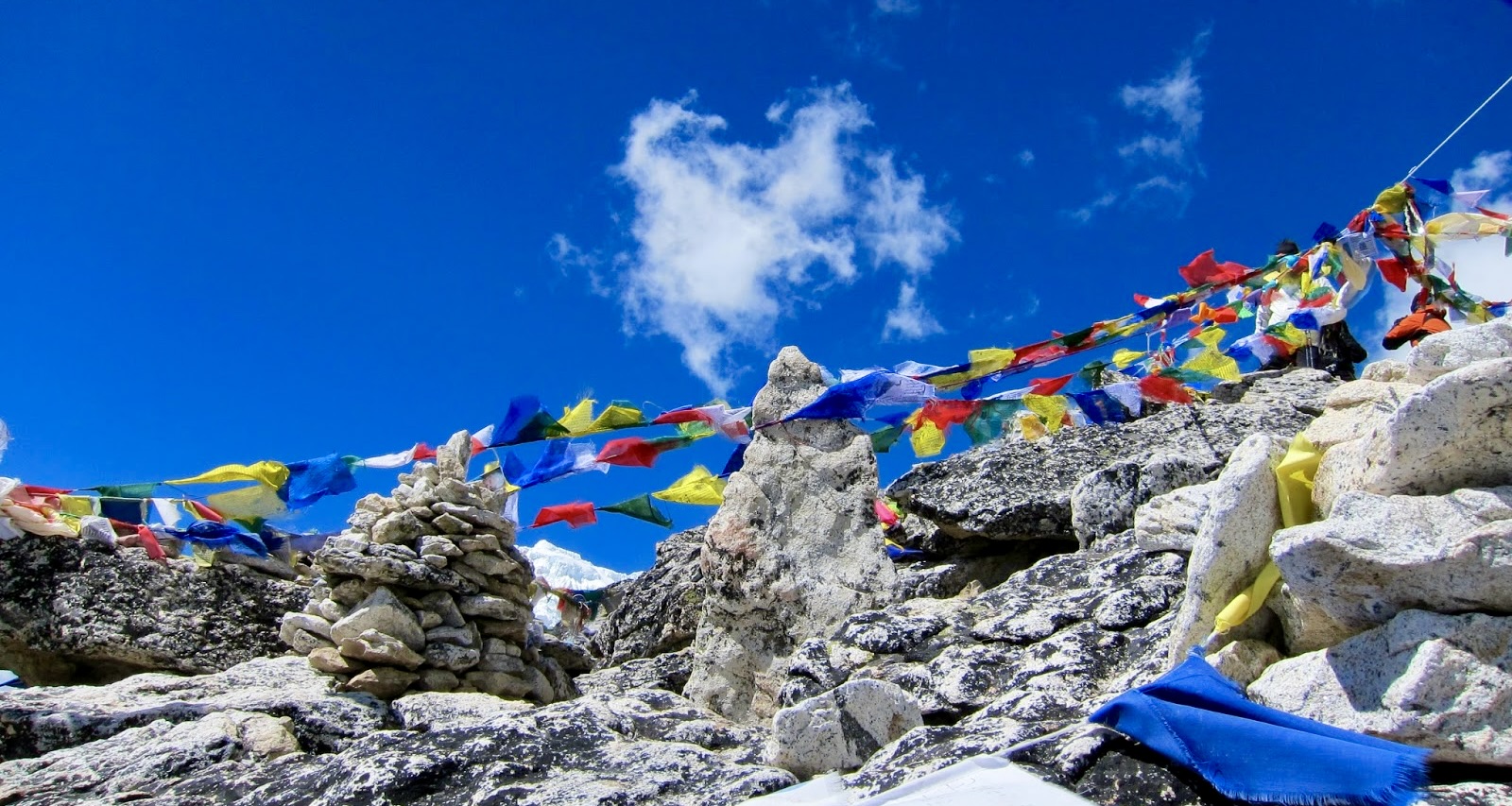
We've guided countless adventurers to Everest Base Camp during autumn, and we can confidently say this season transforms the world's most famous trek into something truly magical. The crystal-clear mountain views we experience during October and November are unmatched – Everest, Lhotse, and Nuptse stand razor-sharp against brilliant blue skies, creating photo opportunities that summer's clouds simply can't deliver.
Our trekkers consistently tell us that autumn's stable weather patterns make the challenging journey significantly more enjoyable. We rarely encounter the monsoon rains that plague summer months or the brutal cold that makes winter treks nearly impossible. The moderate temperatures mean we can trek comfortably during the day while enjoying cozy evenings in teahouses.
The trail conditions we navigate in autumn are at their absolute best. Monsoon rains have cleared the dust but haven't yet given way to winter's ice and snow. We find river crossings safer, stone steps less slippery, and overall footing more secure. Our success rates for reaching base camp peak during these months because weather delays become rare exceptions rather than daily concerns.
Annapurna Circuit Spectacular Fall Colors
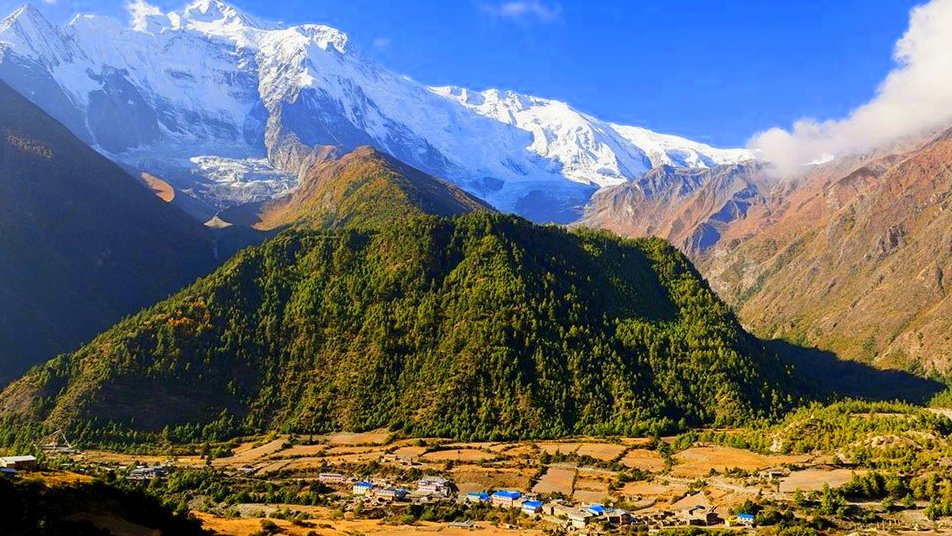
We consider the Annapurna Circuit during autumn to be Nepal's most visually stunning trek. The rhododendron forests we walk through explode in brilliant reds and oranges, creating a natural gallery that stretches for miles. Our photographers spend hours capturing the interplay between golden deciduous trees and the snow-capped Annapurna massif towering above.
The diversity we encounter along this circuit becomes even more pronounced in autumn. We start in subtropical valleys where rice terraces gleam golden-yellow in the harvest season, then climb through temperate forests painted in autumn hues, finally reaching alpine zones where early snow dusts the peaks. This elevation gradient means we experience three distinct seasons in a single trek.
Our groups particularly appreciate how autumn weather makes the challenging Thorong La Pass crossing much safer. We typically enjoy clear, calm conditions at 17,769 feet, with visibility extending for miles in every direction. The stable high-pressure systems that dominate autumn weather mean we rarely need contingency plans for pass crossings.
Langtang Valley's Autumn Charm
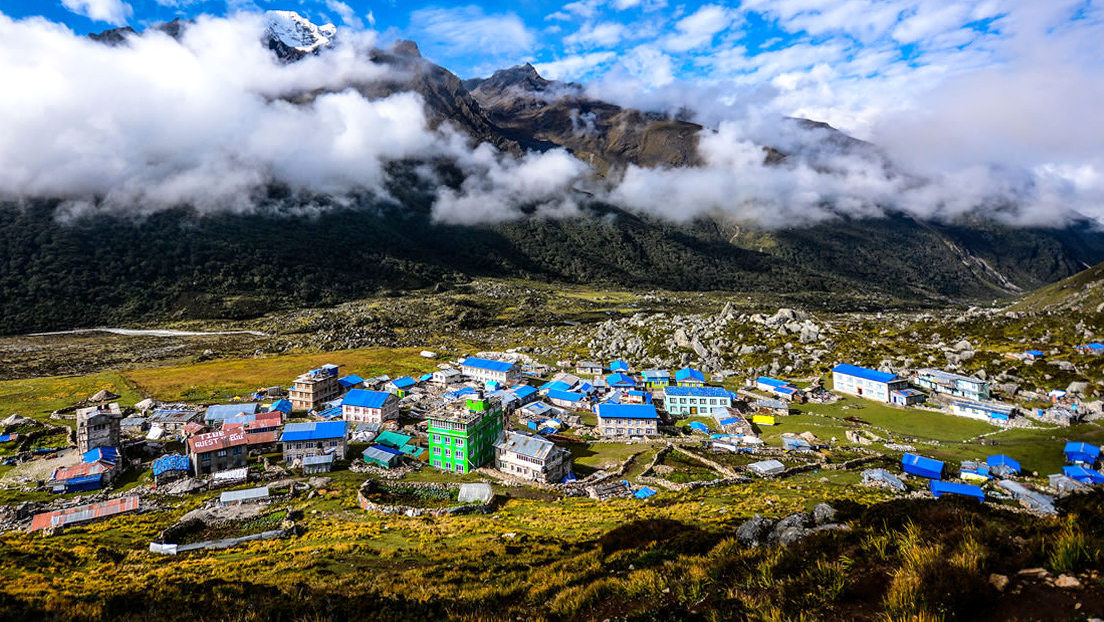
We've discovered that Langtang Valley offers some of Nepal's most intimate autumn trekking experiences. The valley's unique position creates a natural amphitheater where we're surrounded by towering peaks that seem close enough to touch. During autumn, the clear air amplifies this effect, making Langtang Lirung and Ganesh Himal appear almost three-dimensional.
The cultural experience we provide in Langtang becomes especially rich during autumn harvest season. We time our treks to coincide with local festivals and potato harvests, giving our trekkers authentic glimpses into Tamang and Tibetan mountain life. The community lodges we use become gathering places where locals share stories and traditional foods with our groups.
Recovery from the 2015 earthquake has transformed Langtang into a model of resilient mountain communities. We work directly with rebuilt lodges and new trails that showcase both natural beauty and human determination. Our autumn treks here support local economies while offering some of Nepal's most rewarding mountain experiences.
Manaslu Circuit Less Crowded Alternative
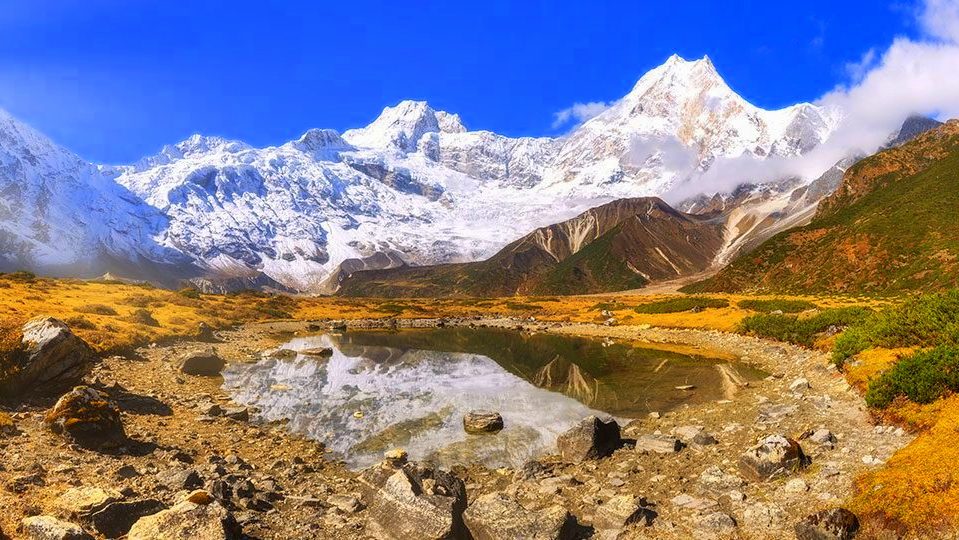
We've positioned the Manaslu Circuit as our premium autumn alternative for trekkers seeking Everest-quality views without Everest-level crowds. The restricted area permits we arrange ensure that our groups experience genuine wilderness solitude while traversing some of Nepal's most dramatic mountain terrain.
The autumn weather patterns we encounter on Manaslu create perfect trekking conditions around Larkya La Pass. We've found that October and November offer the most reliable windows for crossing this technical 17,100-foot pass. The stable weather means we can take time to appreciate the stunning 360-degree mountain panorama that includes Manaslu, Himlung Himal, and Cheo Himal.
Our Manaslu treks showcase incredible biodiversity that autumn enhances beautifully. We walk through forests where blue sheep graze among golden birch trees, and our wildlife spotting success rates peak during these months. The clear autumn air means we often spot snow leopard tracks and enjoy extended views of the Tibetan plateau beyond.
Upper Mustang Desert Landscape Benefits
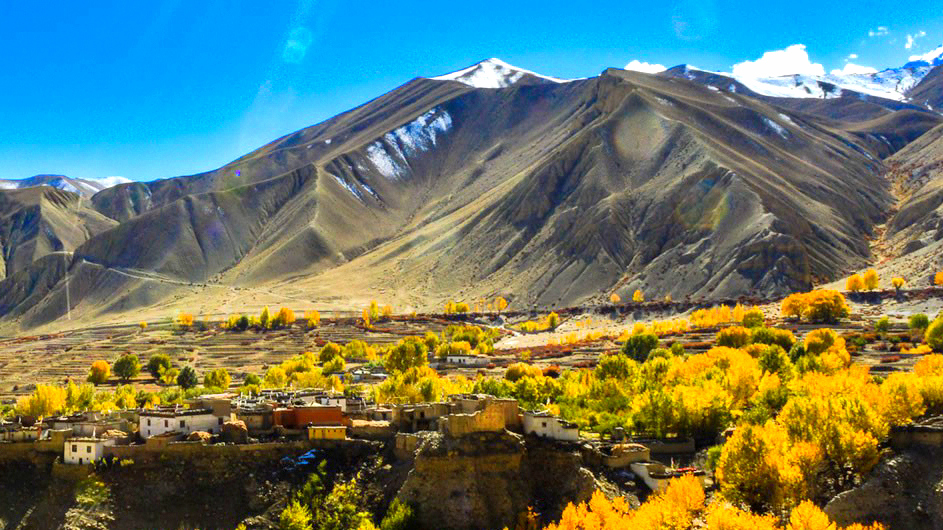
We design our Upper Mustang treks specifically to take advantage of autumn's unique benefits in this desert kingdom. While other regions depend on clear skies, Upper Mustang's rain shadow location means we enjoy perfect trekking weather when other areas might still experience late monsoon effects.
The ancient walled city of Lo Manthang becomes our base for exploring cave monasteries and traditional Tibetan culture that feels frozen in time. We arrange our autumn departures to coincide with local harvest festivals, when the normally austere landscape comes alive with celebrations and traditional ceremonies.
Our horseback riding options in Upper Mustang reach their peak during the autumn months. The firm ground conditions and mild temperatures create ideal riding weather, and we can arrange extended horse treks that explore remote valleys and ancient trading routes between Nepal and Tibet. The dramatic geological formations we encounter – colored cliffs, wind-carved canyons, and ancient lake beds – stand out brilliantly against autumn's crystal-clear skies.
What Makes Autumn Weather Perfect for Trekking
Crystal Clear Mountain Panoramas Daily
We've experienced countless sunrise views across the Himalayas, and nothing compares to autumn's crystal-clear visibility. During our October and November treks, we consistently enjoy panoramic mountain views that stretch for hundreds of kilometers. The post-monsoon atmosphere creates perfect conditions where dust and moisture have settled, leaving behind incredibly clean air that photographers and adventurers dream about.
Our clients regularly capture stunning shots of Everest, Annapurna, and Manaslu ranges from distances that would be impossible during other seasons. We've watched trekkers stand speechless at viewpoints like Poon Hill and Kala Patthar, witnessing mountain peaks that appear so close you could reach out and touch them. The clarity extends beyond just the major peaks - we can identify individual ridges, glaciers, and even climbing routes on distant mountains.
Weather patterns during autumn create stable high-pressure systems that push away clouds and haze. We've guided groups who've enjoyed consecutive days of clear skies, something that's rare during spring when afternoon clouds often roll in. This reliability means we can confidently plan our trekking schedules around key viewpoints, knowing that our clients will likely experience those jaw-dropping Himalayan panoramas they've traveled thousands of miles to see.
Comfortable Daytime Hiking Temperatures
We design our autumn treks around the perfect daytime temperatures that make hiking genuinely enjoyable. At mid-elevations between 2,000-3,500 meters, we experience ideal conditions ranging from 15-20°C (59-68°F) during the day. These temperatures allow our trekkers to maintain steady paces without overheating, while still wearing comfortable layers that can be adjusted as needed.
Our experience guiding autumn treks shows that people naturally feel more energetic and motivated when temperatures are moderate. We've noticed trekkers can walk longer distances without fatigue compared to the exhausting heat of pre-monsoon seasons or the bitter cold of winter months. The moderate warmth keeps muscles loose and reduces the risk of altitude-related complications that cold weather can worsen.
At higher altitudes above 4,000 meters, daytime temperatures remain crisp but manageable, typically hovering around 5-10°C (41-50°F). We've guided countless groups to Everest Base Camp and Annapurna Circuit high passes during autumn, and the consistent temperature patterns make these challenging routes much more accessible. The stable weather means we rarely need to alter our itineraries due to extreme temperature fluctuations, giving our clients confidence in their trekking plans.
Cool Evenings Perfect for Rest and Recovery
We cherish autumn evenings in the mountains when temperatures drop to create perfect sleeping conditions. Evening temperatures typically range from 5-10°C (41-50°F) at moderate elevations, providing that cool, refreshing atmosphere that helps tired bodies recover efficiently. We've found our clients sleep much better during autumn treks compared to the humid nights of monsoon season or the freezing temperatures of winter.
Our teahouse accommodations become cozy retreats when evening temperatures encourage gathering around warming fires and sharing stories from the day's adventures. We've spent countless evenings with our trekking groups, enjoying hot meals and warm drinks while the cool mountain air creates that perfect ambiance that makes Nepal trekking so memorable. The temperature difference between day and night isn't extreme enough to cause discomfort, but provides natural cooling that aids muscle recovery.
We schedule our daily activities knowing that cool evenings will provide natural rest periods. After challenging days on the trail, our bodies welcome the cooler temperatures that reduce inflammation and help regulate sleep patterns. The consistent evening coolness also means we can rely on comfortable sleeping conditions without worrying about heat that might disrupt rest or cold that requires excessive layers and gear.
Low Humidity Levels for Easy Breathing
We appreciate autumn's dramatically reduced humidity levels that make breathing easier at all altitudes. Following the monsoon season, humidity drops to comfortable levels around 30-50%, compared to the oppressive 80-90% humidity we experience during summer months. This reduction creates noticeable improvements in comfort and reduces the feeling of heavy, thick air that can make trekking more challenging.
Our high-altitude specialists have observed that lower humidity levels help trekkers acclimatize more effectively. When air contains less moisture, our lungs can process oxygen more efficiently, reducing some of the breathing difficulties associated with altitude gain. We've guided groups who've reported feeling less winded during autumn treks compared to their previous experiences in more humid conditions.
The dry autumn air also means we sweat less and feel more comfortable throughout long trekking days. We pack lighter clothing loads because quick-drying conditions mean gear doesn't stay damp from perspiration or morning dew. Our clients appreciate how their clothing, sleeping bags, and equipment remain dry and comfortable, eliminating the musty, damp conditions that can make trekking unpleasant during humid seasons. This dry environment also reduces the risk of fungal infections and skin irritations that moisture can cause during extended outdoor adventures.
Essential Packing Guide for Autumn Nepal Treks
Layered Clothing System for Temperature Changes
We've learned from countless treks that autumn's temperature swings in Nepal can catch even experienced trekkers off guard. During our October expeditions, we've watched the thermometer drop from comfortable 15°C afternoons to near-freezing nights in just a few hours. That's why we always recommend our three-layer system that has served us well across thousands of trekking days.
Our base layer strategy focuses on moisture-wicking materials like merino wool or synthetic fabrics. We pack lightweight long-sleeve shirts and thermal bottoms that keep sweat away from your skin during those steep ascents. Cotton is our enemy here – we've seen too many trekkers shivering in damp cotton shirts when temperatures drop unexpectedly.
For the middle layer, we swear by fleece jackets or down vests that trap warm air while remaining breathable. Our guides typically carry both options since fleece works better in damp conditions while down provides superior warmth-to-weight ratio on clear days.
Our outer shell layer protects against Nepal's unpredictable autumn weather. We recommend waterproof-breathable jackets and pants that shield you from sudden rainfall or wind while allowing perspiration to escape. During our Everest Base Camp treks, we've witnessed how quickly afternoon sunshine can turn into evening snow showers above 4,000 meters.
Don't forget accessories that make huge differences in comfort. We pack warm hats, sun hats, gloves, and neck gaiters. Our trekkers often underestimate how much heat escapes through exposed heads and necks, especially during early morning starts when temperatures hover around freezing.
Proper Footwear for Varied Terrain Conditions
We've guided trekkers across every type of terrain Nepal offers, from riverside trails to glacier moraines, and footwear choices can make or break your autumn adventure. Our experience shows that autumn presents unique challenges with morning frost, afternoon mud, and rocky scrambles all in the same day.
Our primary recommendation centers on well-broken-in trekking boots with ankle support and aggressive tread patterns. We prefer boots with waterproof-breathable membranes since autumn brings unpredictable weather patterns. During our Annapurna Circuit expeditions, we've navigated morning ice patches that transform into muddy trails by afternoon.
Boot sizing becomes critical at altitude where feet tend to swell. We advise our trekkers to size up half a size from their normal shoe size and always test boots with the thick socks they'll wear during the trek. Our guides have witnessed too many trekkers suffering from black toenails or blisters because they underestimated proper fit requirements.
We also pack backup footwear options for different situations. Lightweight trail runners serve as excellent camp shoes and work well for easier trail sections. We've found that alternating between boots and runners during multi-day treks helps prevent pressure points and keeps feet healthier.
Sock selection deserves equal attention in our packing strategy. We recommend moisture-wicking wool or synthetic socks in medium thickness, plus we always carry extra pairs. Our trekkers learn quickly that dry socks can transform a miserable hiking day into a comfortable one. We also suggest bringing thin liner socks to prevent friction and blister formation during longer trekking days.
Photography Equipment for Stunning Views
Autumn delivers Nepal's most photogenic conditions, and we've learned exactly what equipment captures these magical moments best. Our photography workshops during peak autumn months have shown us that the right gear can document experiences that last lifetimes.
We recommend DSLR or mirrorless cameras with weather sealing since autumn weather changes rapidly. Our photographers consistently achieve better results with cameras that handle temperature fluctuations and occasional moisture without missing shots. We've seen too many point-and-shoot cameras fail during crucial sunrise moments at places like Poon Hill.
Lens selection plays a huge role in capturing Nepal's diverse landscapes. We suggest packing a wide-angle lens (16-35mm equivalent) for expansive mountain vistas and valley shots. Our guides also recommend a telephoto zoom (70-200mm equivalent) for isolating distant peaks and wildlife photography. Many of our trekkers find that a versatile 24-70mm lens handles most situations effectively.
Battery management becomes critical in cold autumn conditions where power drains faster than expected. We always pack multiple spare batteries and portable power banks with weather-resistant cases. Our photographers learn to keep batteries warm inside jacket pockets and swap them regularly during shooting sessions.
Tripod selection balances weight against stability for those stunning sunrise and sunset shots. We recommend carbon fiber tripods that weigh less but provide solid support for sharp images. Our workshop participants consistently produce better results when they have stable platforms for low-light photography sessions.
Memory cards and storage solutions need redundancy since replacing failed cards during remote treks isn't possible. We suggest bringing multiple high-capacity cards and backing up images regularly on portable hard drives or cloud storage when internet becomes available.
Booking and Planning Your Autumn Trek Experience
Advance Reservation Benefits During Peak Season
Autumn brings Nepal's most spectacular trekking conditions, which means everyone wants to experience the crisp mountain air and crystal-clear views. We strongly recommend booking your trek at least 3-6 months in advance to secure your preferred dates and accommodations. Early reservations give you access to the best tea houses along popular routes like Everest Base Camp and Annapurna Circuit, where rooms fill up quickly during October and November.
When you book early with us, we guarantee your spot even when demand peaks. This means no last-minute disappointments or having to settle for subpar accommodations. We also lock in your rates, protecting you from seasonal price increases that can add 20-30% to your trek costs. Our advance booking system includes flexible cancellation policies, giving you peace of mind if your travel plans change.
We've built relationships with the most reliable tea house networks across Nepal's major trekking regions. These partnerships allow us to secure the cleanest rooms, best meal options, and most reliable Wi-Fi connections available on the trail. During peak autumn season, these premium spots book out months ahead, but our early reservation system ensures you get first pick.
Luxury Holiday Nepal's Autumn Trek Packages
Our autumn trek packages are designed around the season's unique advantages. We offer complete packages that include domestic flights, permits, professional guides, and carefully selected accommodations that showcase autumn's spectacular mountain views. Our Everest Base Camp Autumn Special includes helicopter return options, perfect for capturing the season's famous clear skies and dramatic mountain panoramas.
The Annapurna Circuit Luxury package combines traditional tea house stays with upgraded lodge accommodations in key locations. We handpick properties that offer heated rooms, attached bathrooms, and panoramic mountain views that are especially stunning during autumn's clear weather conditions. Our packages also include cultural experiences in local villages, where autumn harvest festivals add rich cultural depth to your trekking experience.
We customize each package based on your fitness level and interests. Whether you want photography-focused treks that take advantage of autumn's perfect lighting, or wellness-oriented journeys that combine trekking with yoga and meditation, we create experiences that match your vision. Our autumn packages include backup plans for weather delays, though autumn's stable conditions rarely require them.
Accommodation Upgrades Available in Peak Season
Autumn's popularity brings out the best accommodation options across Nepal's trekking regions. We offer strategic upgrades that transform your mountain experience from basic to exceptional. In key locations like Namche Bazaar, Manang, and Ghorepani, we secure rooms in premium lodges that feature attached bathrooms, hot showers, and mountain-view windows that frame autumn's spectacular scenery.
Our upgrade options include heated rooms in high-altitude locations where autumn nights get chilly. These comfortable spaces let you rest properly between trekking days, maintaining your energy and enjoyment throughout the journey. We also arrange stays in lodges with reliable electricity and charging facilities, keeping your devices powered for capturing autumn's photogenic moments.
In popular destinations, we book corner rooms and upper floor accommodations that offer the best mountain views. During autumn's clear weather, these premium spots provide front-row seats to sunrise and sunset displays over snow-capped peaks. Our accommodation network includes family-run lodges where you can experience authentic Nepali hospitality while enjoying modern comfort upgrades.
Professional Guide Services for Enhanced Experience
Our certified guides transform autumn trekking from simple hiking into rich cultural and natural education experiences. They know exactly when and where to position you for the season's best mountain photography opportunities. Autumn's clear skies create perfect conditions for learning about Himalayan geography, and our guides help you identify peaks, glaciers, and geological features that are clearly visible during this season.
We match guides to your interests and experience level. Our mountain photography specialists know the best lighting conditions and viewpoints that autumn weather provides. Cultural guides share harvest season traditions and festival customs you'll encounter in mountain villages during your trek. Our medical-trained guides ensure your safety while helping you acclimatize properly to high altitudes.
Our guide services include pre-trek briefings where we review route conditions, weather patterns, and cultural highlights specific to autumn trekking. They carry communication equipment that keeps you connected with our support team, and their local knowledge helps navigate any seasonal variations in trail conditions. We also provide porter services that work seamlessly with our guide teams, ensuring your gear is properly managed while you focus on enjoying autumn's incredible trekking conditions.
Autumn truly stands out as the golden season for trekking in Nepal, offering us the perfect combination of crystal-clear mountain views, comfortable temperatures, and reliable weather conditions. We've covered why October and November provide the best trekking windows, explored the most rewarding routes from Everest Base Camp to Annapurna Circuit, and discussed how the stable weather patterns make every step of our journey more enjoyable. The comprehensive packing essentials we've outlined will help us stay comfortable throughout our adventure, while proper planning and booking strategies ensure we make the most of this incredible season.
Our autumn trek in Nepal promises to be an unforgettable experience filled with breathtaking Himalayan panoramas and cultural discoveries. We encourage you to start planning your autumn adventure now, as this popular season fills up quickly with fellow trekkers who understand the magic of Nepal's most spectacular months. Whether you choose the classic Everest Base Camp route or venture into the diverse landscapes of the Annapurna region, autumn will reward us with the clearest skies and most memorable mountain moments of our lifetime.
If you need any further information, please contact us, Email: at [email protected], Phone: +977- 985 100 5129 (WhatsApp)

